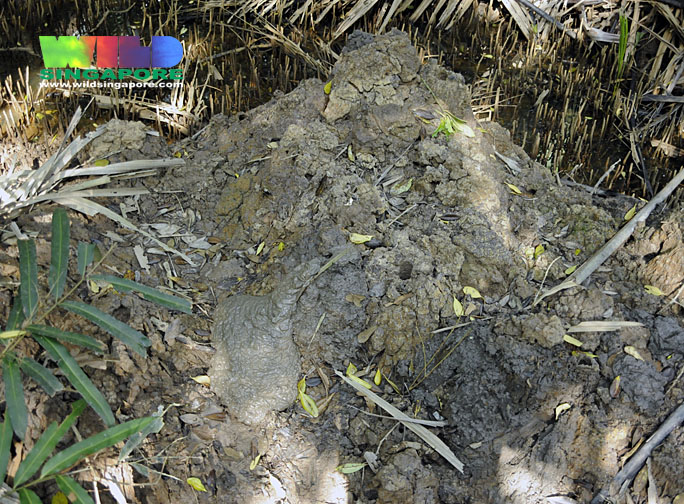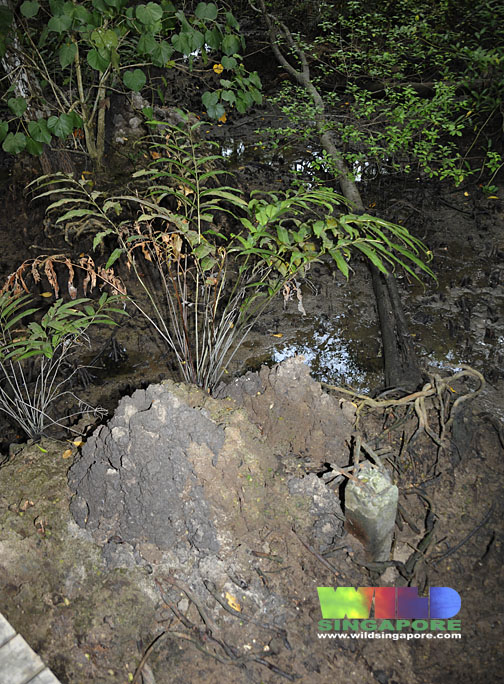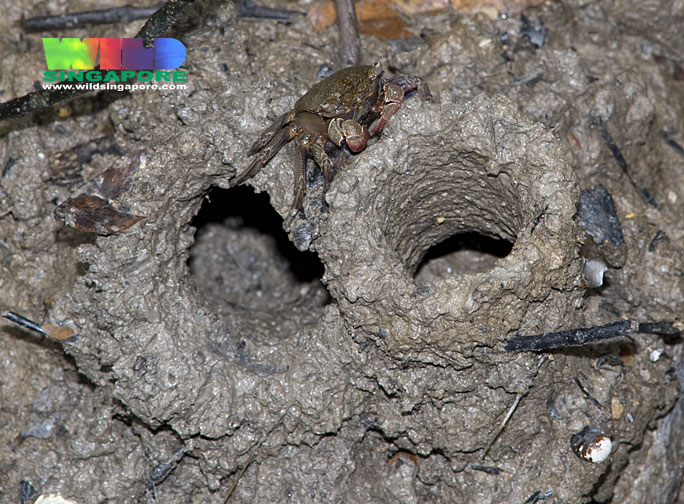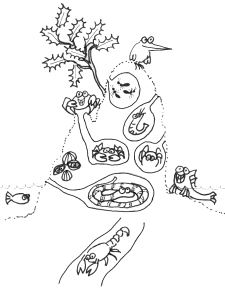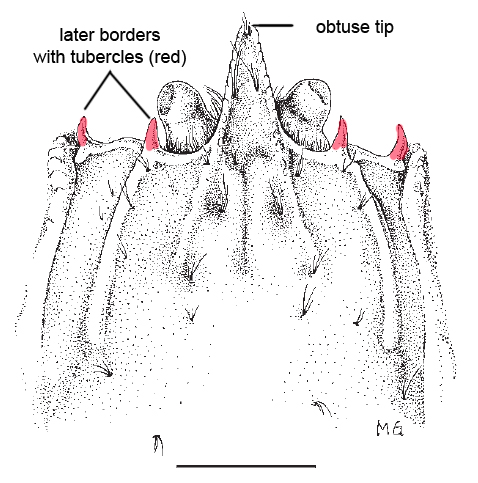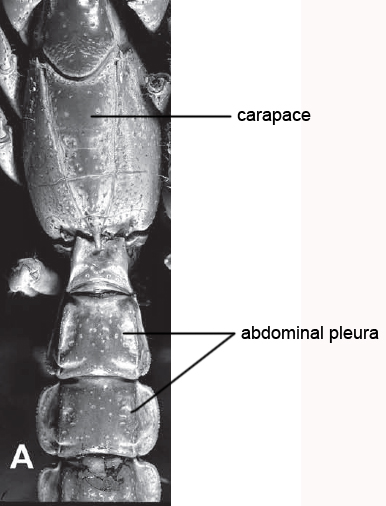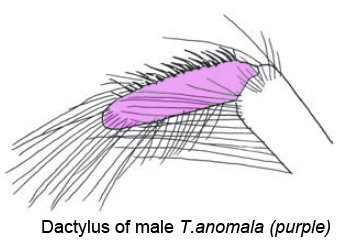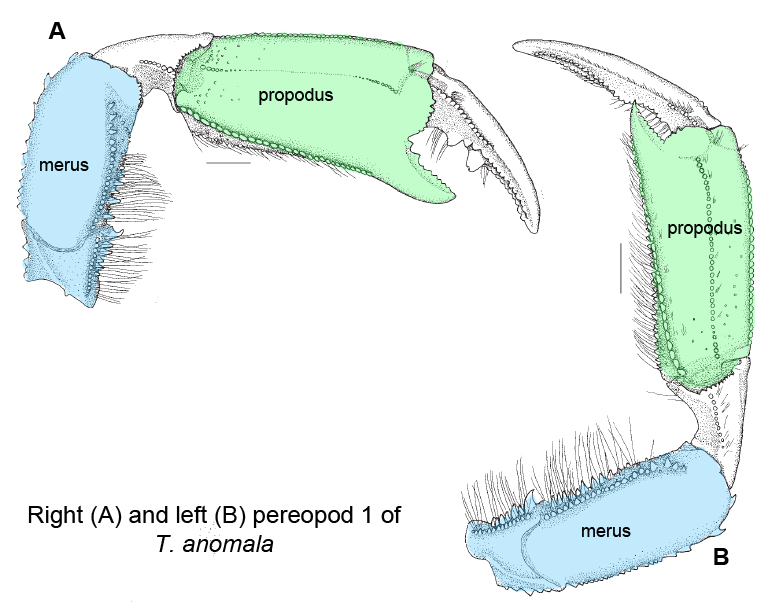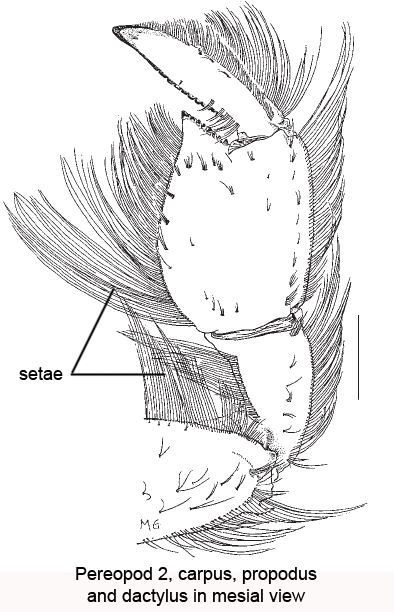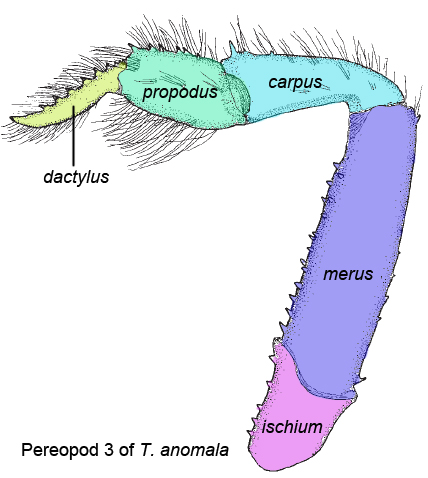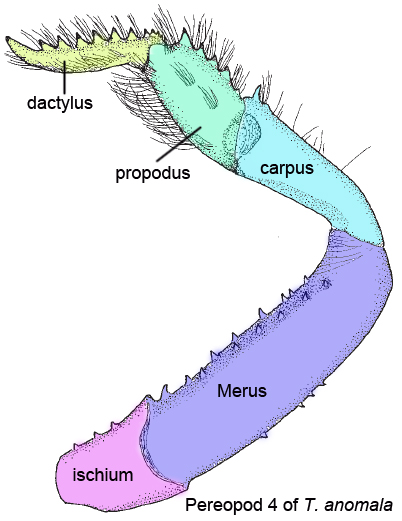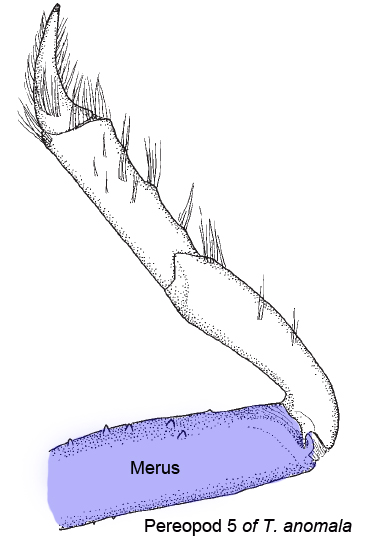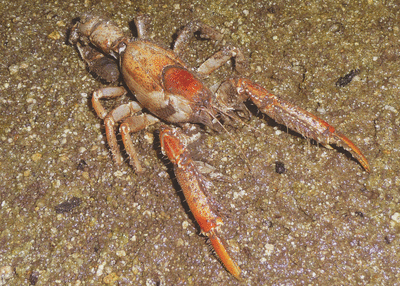
" * " denotes advanced/technical terms and descriptions
][ Introduction ][
Table of Contents
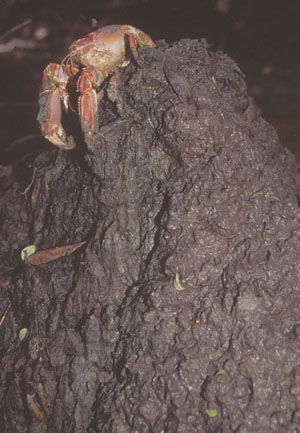 |
| Mud Lobster (T. anomala) on the chimney of its mound |
Next time you walk around Sungei Buloh Nature Reserve, Pulau Semakau or Pasir Ris Mangroves, do keep a lookout for the volcano-shaped looking mounds usually located at the back of the mangroves! These are mounds of the important "condominium builders" in the mangrove ecosystem - MUD LOBSTERS!
Deemed as an important keystone species in the mangrove ecosystems, the scorpion mud lobsters (Thalassina anomala) would spend most of its time building large mud "volcano" mounds. Even though these crustaceans resemble true lobsters, they are, in fact, more closely related to ghost shrimps. Some of their mound systems can extend up to a few metres in height and length. Mud lobsters use their first pair of modified legs to burrow and dig up mud. They are regarded as keystone species as their constant digging and burrowing action helps to bring fresh mud to the surface, aerate the oxygen-poor mangrove soil and recycle the nutrients in the mangrove ecosystem. In addition, the large mound systems are also homes to some plants and animals. The presence of a spew of black mud is an indication that the mud lobster may possibly be actively excavating the soil.
Unlike other decapods which are usually harvested/caught for food, there is no special fishery for this creature despite being edible. It is deemed as "useless lobster" due to its bland taste (11). In Thailand, mud lobsters are consumed as medicine against asthma.
General Information on Mud Lobster in Singapore
There are five species of mud lobsters recorded in Singapore, the other four being T. gracilis, T. spinirostris, T. kelanang and T. krempfi (20). Mud lobsters are considered to be "Endangered" according to the Red List of Threatened animals of Singapore. This threat to their existence is possibly caused by the lost or degradation of their preferred habitats, the mangroves. With the decreasing number of mangrove land area in Singapore due to human activities such as reclamation, urbanization and pollution, this would mean that there would be lesser mud mounds. This may ultimately affect the mud lobster population in Singapore. As a keystone species of the mangroves, their existence in the mangrove is crucial. If these mud lobsters disappear, so will their mud mounds which houses a myriad of plants and animals living in there.Credits: Professor Bruce Jayne (University of Cincinnati)
Back to top
][ Name ][
| Binomial: |
Thalassina anomala Herbst(10), 1804 |
| Vernacular: |
Scorpion Mud Lobster |
| Synonyms: |
Cancer (Astacus) anomalus Herbst, 1804; Thalassina scorpionides Latereille, 1806; Thalassina scarbaLeach, 1814; Thalassina scorpionoïdes - Guérin-Méneville, 1843; Thalassina talpa hite, 1847 (nomen nudum); Thalassina chilensis Steenstrup & Lutken, 1862; Thalassina maxima Hess, 1865 |
| Local Names: |
AUSTRALIA: Mud Lobster; FIJI: Maná, Tola; INDONESIA: Udang katak, Udang tanah, Udang petsje (Amboina); JAPAN: Okinawa-ana-jyako; MALAYSIA: Udang ketak; PHILIPPINES: Kolokoy, Kulokoy, Palatak (Tagalog Language), Oson, Uson, Mania (Cebu language); THAILAND: Mae hop. |
Etymology
Description and derivation of name are neither known nor recorded.
Back to top
][ Distribution ][
(If the the above Google Map widget is not working, click here <Map_Distribution.JPG > to see a still image of the distribution map.)
Thalassina anomala can be found in Indo-West Pacific region, from the west coast of India, Andaman Islands to South West of Japan (Ryukyu Islands), Myanmar, Vietnam, the Philippines, Thailand, Singapore, Malaysia, Indonesia, New Guinea, New Britain Island, Fiji, Vanuatu, Solomon Islands and Samoa.
(Distribution map was created with references from Holthuis (1991) and SeaLifeBase Thalassina Anomala Country Page.)
Back to top
][ Biology ][
Lifestyle
T. anomala is a very shy organism which is more active at night (4) (15) (21). Because of this, it is uncommon to find it crawling out, moving about around its habitat in broad daylight. Spawing period is highest between September and November based on a study conducted in Rewa, Fiji (22).
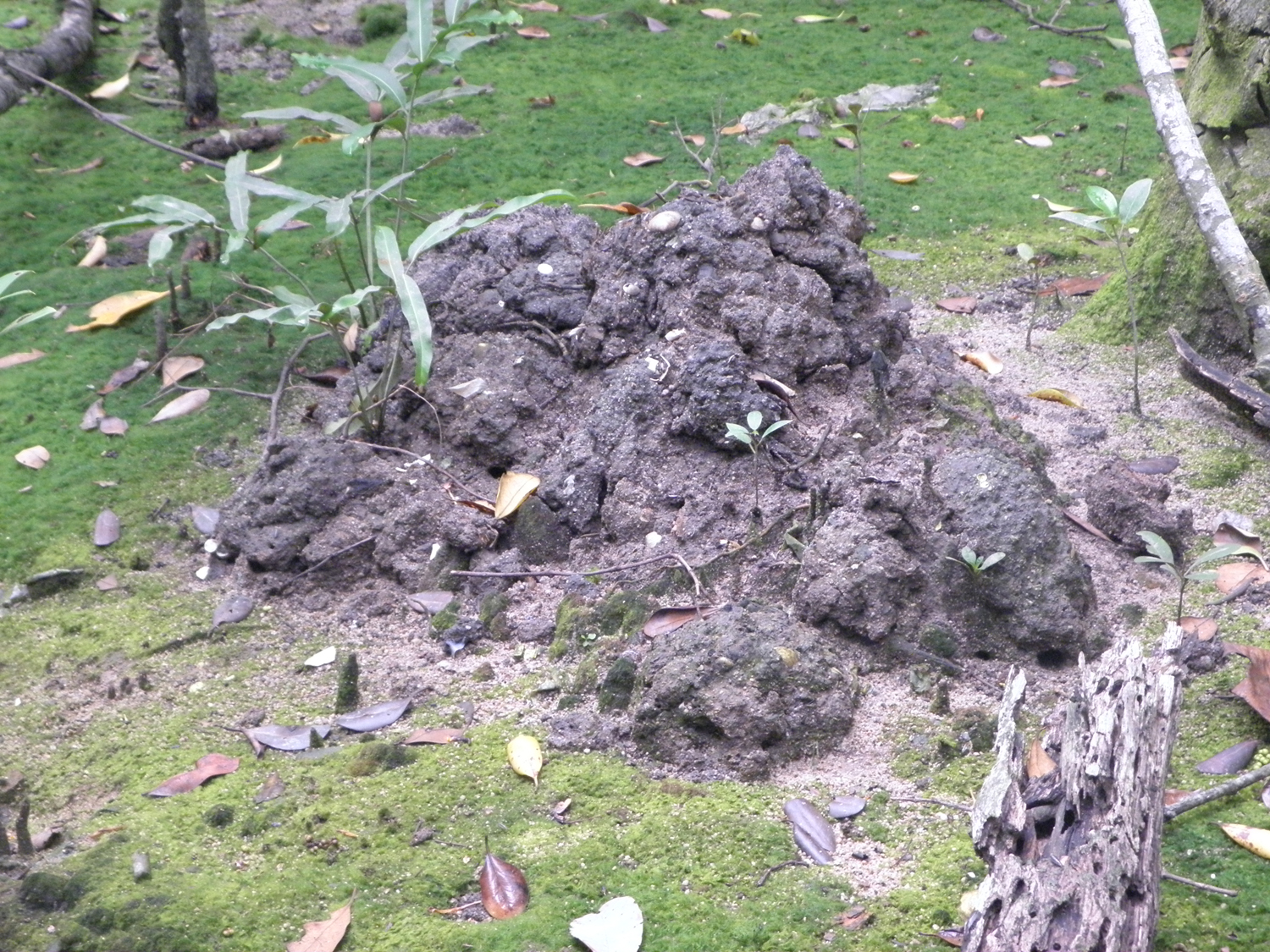 |
| Fresh mud lobster mound at the back of Mandai Mangroves (Photograph taken by: Ariff Aziz) |
T. anomalacan be found living at the edge of estuaries near high tide mark (14) (21) or in the littoral and supralittoral zone (burrowing site) (11). It can also be found in mangroves forests and swamps(1)(3)(5)(7)(8)(9)(15)(16)(17)(19)(23)(26). The burrows are located on the upper edge of shores(3) or in low tide zone to far above high tide zone (1). The chimney of this organism’s mounds can go up to 75cm high with some more complex multiple chimneys forming hills of mud of up to 1.5m high (11) (23). The burrows would go vertically downwards after which the tunnels may be formed in a zigzag and branched manner. The depth of the burrows has go down to as low as 2.5m deep.
|
|
The importance of its burrows/mounds
The burrows and mounds of T. anomalaare home to several plants and other species such as Sesarma crabs (6)(15) (24), spiders, snakes, social insects (e.g. termites), ferns(18), snails, flatworms, bivalves. The side of the mound is also home to mangrove mud shrimp, Wolffogebia phuketensis Sakai (19). The mounds also have positive impact on mangrove regeneration(8). The importance of its mounds/burrows as homes to other flora and fauna and burrowing action made it a keystone organism in the mangroves.
|
|
Feeding Habits
T. anomalafeeds on mud and obtain nutrients from algae, protozoa and small organic matters in the mud (12) (19) (23) (25).
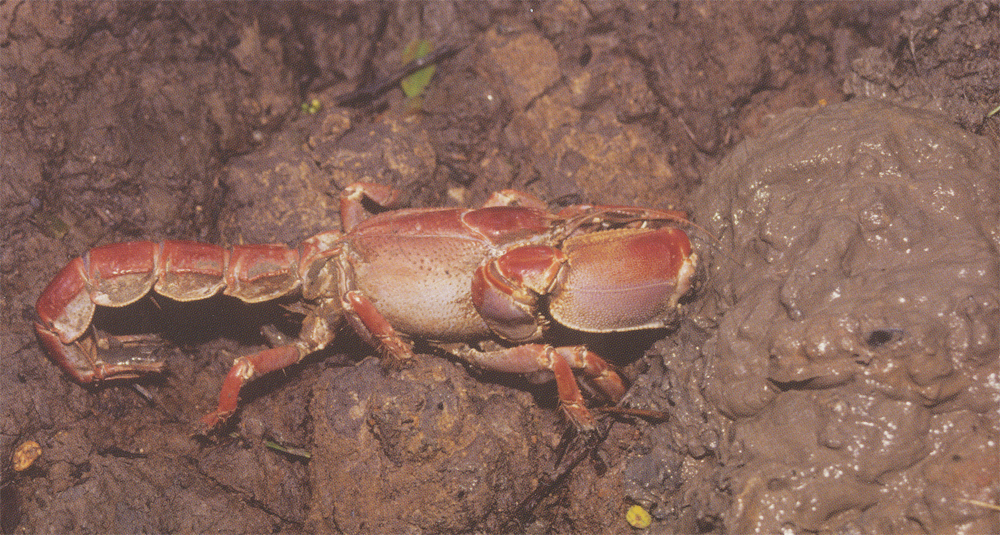 |
| A mud lobster feeding on mud. Photograph taken by: Sivasothi N. |
Physiology
It was reported that T. anomala is able to survive hypoxic conditions in the mud-water layer at the base of its burrow despite living deep below the surface (13). This organism has developed an amazing tolerance for its anaerobic living conditions in the mangrove mud. In laboratory settings, it is able to survive out of the water for a couple of hours and is highly dessication-tolerant (19).
Effects of its ecological behaviour to society
T. anomalais considered a pest in many areas due to the damage it cause to bunds of prawn ponds and dykes of ponds(11) (13). The burrows of the mounds also provide a suitable breeding place for mosquito and counter-productive to anti-malarial measures(2). Mound formation is also detrimental to agricultural development as the subsoil material of the mounds would acidify when exposed to air which would affect agricultural processes.
Back to top
][ Taxonavigation ][
The taxonavigation section aims to highlight the classification T.anomalais based on its rank and taxa. This would aim users/readers in determining the exact location in the taxonomic hierarchy.
Kingdom: Animalia
Phylum: Arthropoda
Subphylum: Crustacea (Brünnich, 1772)
Class: Malacostraca (Latreille,1802)
Subclass: Eumalacostraca (Grobben,1892)
Order: Decapoda (Latreille,1802)
Suborder: Pleocyemata (Burkenroad,1963)
Infraorder: Thalassinidae (Latreille,1831)
Superfamily: Thalassinoidea (Latreille,1831)
Family: Thalassinidae (Latreille,1831)
Genus: Thalassina (Latreille,1806)
Species: Thalassina anomala (Herbst,1804)
Source: Integrated Taxonomic Information System, Txn Serial No 553060
][ Type Information ][
The type information serves to inform readers on the exact location of the first and original holotype specimen.
The holotype for Thalassina anomala (then known as Cancer anomalus) can be found at Zoologisches Museum der Humboldt-Universitat (ZMB), Berlin, Germany. Holotype ID is no. 1256 and the specimen is dry and in reasonable condition.
Back to top
][ Diagnosis* ][
T. anomala can be distinguished from other Thalassina spp. based on presence of obtuse tip rostrum, unarmed or bordered cervial groove with the presence of few tubercles projections (Figure 1) and long dorsomedian process of carapace (Figure 2). It is also usually the larger species compared to the other species and more widely distributed.
Note: It is very important to know how to differentiate the different Thalassina species as previously, there was some confusion over the actual species identification as cited by McNae (1968). For instance, it was reported that T.anomala was abundant in the vicinity of Port Darwin, Australia but in actual fact, T. squamifera or T. emerri are more likely to occur there!
For a more elaborate differentiation of characterisitics across all Thalassina spp., refer to the table below.
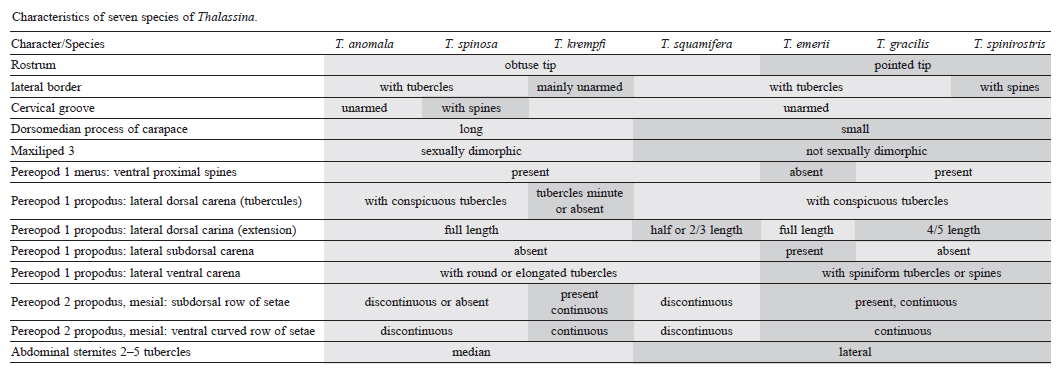
Back to top
][ Description* ][
Note: To maintain the authenticity of the organism's description, the following information is directly extracted from Ngoc-Ho, N. & M. de Saint Laurent (2009).
For an explanation of technical terms, refer to the Glossary at the bottom of the page.
Morphology
Body colour: Reddish brown or yellowish.
Body size and parts: Can go up to 16 to 20 cm in length. It has tough and firm outer protective layer (integument). The rostrum (Figure 1) is short and triangular in shape with an obtuse tip. It is also medially depressed with tubercles present (Figure 1, red highlights) on lateral borders. It has small eyes, large ocular and antennal spines and a long dorsomedian process of carapace. In dorsal view, the carapace has an elongated oval shape and it measures less than 1/3 of total body length for the adults. In males, the long and narrow abdomen is more than five times as wide whereas in females, it is about four times as wide. The abdominal pleura (Figure 2) of T. anomala are often large and rounded, bordered with tubercles or denticles. Antennal scale is usually small or absent. The 3rd mouthpart (maxilliped3) is sexually dimorphic, with short, firm setae found at the tip of dactylus in males (Figure 3, purple highlights).
|
|
|
Pereopod
Pereopod 1 is asymmetrical in nature with both chelae being subchelate. Merus (Figure 4; blue) has three to seven proximal large spines whereas the propodus (Figure 4; green) has faint or well defined lateral median carina. Lateral dorsal carina extending whole length, lateral ventral carina with round or elongated tubercles. In males, this segment is usually unequal but is subequal and similar in females though there are some variations.
Pereopod 2 propodus with row of small tufts or short or inconspicuous setae near dorsal border of mesial surface, curved row of similar small tufts of setae near two-thirds and distal half of ventral border (Figure 5).
|
|
Pereopod 3's (Figure 6) ischium has three to five central spinules. Merus has one proximal, one distal spine on dorsal border and about 4-12 spinules, usually variable in number, between the two. Carpus has one large distal spine followed by two to five smaller ones on dorsal border. Both propodus and dactylus has five to ten dorsal corneous (horn-like) spines, with the dactylus tip also being corneous.
Pereopod 4 (Figure 7) has three ventral spinules on ischium, 4-12 dorsal spicules on merus with varying number on ventral front and back row. Carpus has one dorsal distal spine, whereas propodus and dactylus has five and ten corneous dorsal spines respectively. The tip of dactylus is corneous .
Pereopod 5's (Figure 8) merus has five or six ventral spine-loooking tubercles.
|
|
|
Telson and Uropod
Telson: Slightly narrower with a broadly rounded posterior margin and the length is as long as the previous segments.
Uropod: Bristle-like shaped.
Back to top
][ Del.icio.us RSS Feed ][
[ https://delicious.com/v2/rss/ariff_andraz]
If you have found links about T. anomala which are not linked up in the above RSS feed, do drop a comment in the comment box below!
| Subject | Author | Replies | Views | Last Message |
|---|---|---|---|---|
| Comment added: | 3 | 157 |
Nov 16, 2011 by |
Back to top
][ Literature/ References/ Further Readings ][
- Adiwiryono. S., Sukristiyono & V. Taro 1984. The occurrence of crustaceans in the Tanjung Bung in mangrove forest, south Sumatra, Indonesia. In : Soepadmo, E., A. N. Rao & D. J. Macintosh (eds.). Proceedings of Symposium on Mangrove Environment Research and Management. Kuala Lumpur, 25- 29August 19SO University of Malaya & UNESCO: 241 – 257
- Andriesse. J. P., N. v. Breemen & W. A. Blokhuis. 1973. The influence of mudlobsters (Thalassina anomala) on the development of acid sulphate soils in mangrove swamps in Sarawak (East Malaysia). In: Proceedings of an International Symposium on Acid Sulphate soils. 1972. Wageningen. The Netherlands. Pp. 11 - 39.
- Chuang, S. H. 1961 On Malayan shore: Muwa Shoa (ed) .Singapore. 226 pp.
- Das. N. & A. Misra, 1987. Biological observations on the burrowing ghost shrimp Thalassina anomala (Herbst) from Sundarbans. West Bengal, India . Journal of the Indian Society of Coastal Agricultural Research, 5: 333- 338.
- Ekman, S. P., 1967. The warm-water fauna of the shelf: Introductory survey. In : Zoogeography of the Sea (Translated from Swedish by E. Palmer) (second edition). London. 417 pp.
- Ferguson. D. S., 1951. Control of damages to bunds by burrowing lobsters and crabs. Malaysian Agricultural Journal. 34(2) 61 – 64.
- Havanond, S., 1987. Effects of mud lobsters (Thalassina anomala Herbst) on plant succession in mangrove forests. Thailand. Bulletin of Marine Science. 41: 635.
- Havanond. S., S. Aksornkoae & T. Nakamura. 1999. Mangrove succession and mud lobster mounds in Ranong, Thailand. Phuket Marine Biological Center Special Publication, 20: 21-34.
- Hedgpeth, J. W. 1957. Estuaries and lagoons. 2 . Biological aspects. In: Hedgpeth. J. W. (eel.). Treatise on marine ecology and palaeoecology. vol. I. Ecology. The Geological Society of America, Memoir, 67: 693-729.
- Herbst, J.F.W., 1804. Versuch einer Naturgeschichte der Krabben und Krebse nebst einer systematischen Beschreibung ihrer verschiedenen Arten, 3(4): 1-49, pls. 59-62.
- Holthuis. L. B., 1991. FAO species catalogue. Vol. 13. Marine lobsters of the world. An annotated and illustrated catalogue of species of interest to fisheries known to date. FAO Fisheries Synopsis, 125(13): 1- 292.
- Johnson, D. S., 1961. The food and feeding of the mud lobster. Thalassina anomala (Herbst). Crustceana. 2: 325-326
- Macintosh, D. J., 1988. The ecology and physiology of decapods of mangrove swamps. Symposia of the Zoological Society of London. 59: 315-341.
- Marshall. S. M. & A. P. Orr. 1960. Feeding and Nutrition. In Waterman, T H. (ed.). The Physiology of Crustacea I . Academic Press. New York. 227 - 258 pp.
- McNae, W., 1968. A general account of the Fauna and Flora of Mangrove swamps and forests in the Indo- West-Pacific region. -4dl"tmces in Marine Biology: 6: 73- 270.
- McNeill, F. A.. 1968. Crustacea. Decapoda and Stomatopoda. Scientific Report of Great Barrier Reef Expedition 1928-1929. 7(1): 1-98. British Museum Natural History): London
- Morton J. E. & D. A. Challis. 1969. The biomorphology of Solomon Islands shores. with a discussion of zoning patterns and ecological terminology. Philosophical Transaction of the Royal Society of London. Ser. B. 255
- Ng, Peter K. L. & N. Sivasothi, 1999. A Guide to the Mangroves of Singapore I (Plant Diversity). Singapore Science Centre. 168 pp.
- Ng. P. K. L. & N. Kang. 1988. The mud lobster Thalassina. Nature Malaysiana. 13(4): 28-31
- Ngoc-Ho, N. & M. de Saint Laurent, 2009. The genus Thalassina Latreille, 1806 (Crustacea; Thalassinidea: Thalassinedae). Raffles Bulletin of Zoology, Supplement No. 20: 121-158
- Pearse, A. S., 1911. On the habits of Thalassina anomala (Herbst). The Philippine Journal of Science. 6(4): 213-217 pp.
- Pillai. G., 1985. The Mana, or mud lobster. Domodomo. 3: 2- 10.
- Sankolli. K. N., 1963. On the occurrence of Thalassina anomala(Herbst), a burrowing crustacean, in Bombay waters and its burrowing methods. Journal of the Bombay Natural History Society, 60: 600-605
- Scharff. J. W. & M. W. F. Tweedie. 1942. Malaria and the mud lobster. Transactions of the Royal Society of Tropica Medicine and Hygiene. 36: 41-44.
- Vervey. J., 1930. Einiges Liber die Biologie Ostindischer Mangrove Krabben. Treubia. 12(2): 169-261
- Vohra. F. C., 1987. Mangrove swamp. In: Encyclopedia of Science and Technology. 6th ed. McGraw - Hill Professional. New York. 370- 371 pp.
Back to top
][ Links to relevant sites ][
Fossil Collection (Trilobites Nocturne)
Sea Life Base Site of Thalassina Anomala
Integrated Taxonomic Information System, Txn Serial No 553060
Sistema Integradode Información Taxonómica
First name of Thalassina Anomala, Cancer anomalus
Taxonomic information in NCBI
Back to top
][ Brief Glossary of Key Technical Terms ][
Carina (pl. carinae): Ridge or crest.
Carpus: The third segment of a pereiopod counted from the tip of the leg; it is situated between the propodus and merus.
Cervical groove: An often deep transverse groove over the middle of the carapace, the lateral parts of which are usually curved forward.
Dactylus: The ultimate segment of a pereiopod.
Ischium: The fifth segment of a pereiopod counted from the tip of the leg; it is situated between merus and basis.
Maxilliped - The three maxillipeds (first, second, and third) are considered to belong to the mouth parts because of their role with the ingestion of food. The first maxilliped is flat and leaf-like; the second and third, especially the latter, are more leg-like in shape.
Merus: The middle segment of a pereiopod, the fourth counted from either end.
Pereipod: Also written as pereopod or peraepod - The thoracic appendages behind the mouth parts, i.e. the appendages of somites 10 to 14 (= thoracic somites 4 to 8). The pereiopods consist of seven segments, these are, from proximal to distal: coxa, basis, ischium, merus, carpus, propodus, and dactylus.
Pleuron (pl. pleura): The lateral part of the chitinous ring that surround each somite, the dorsal part being the tergite, the ventral the sternite. The pleura of abdominal somites are often well developed and show as lateral plates that are directed downward and protect the pleopods; together with the sternites they may form a gutter-like cavity on the lower surface of the abdomen, which holds the pleopods and the eggs.
Propodus: The one but last segment of a pereiopod situated between the dactylus and the carpus.
Rostrum: A prolongation of the median part of the anterior carapace margin, which projects forward between and often beyond the eyes.
Setae: Bristle- or hair-like structures.
Like this page? Share it!
Back to top
